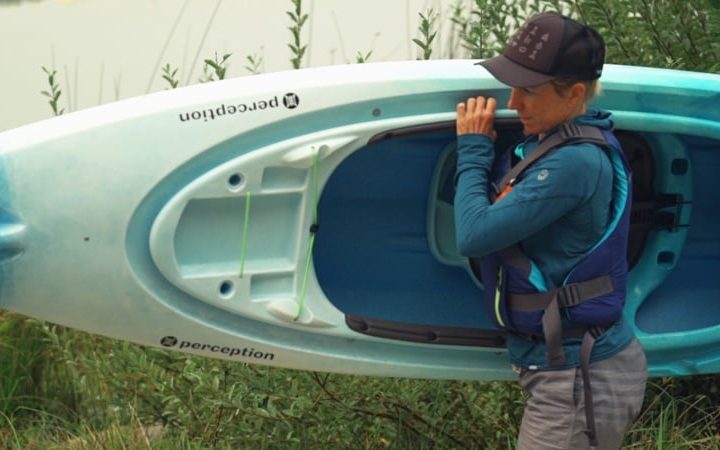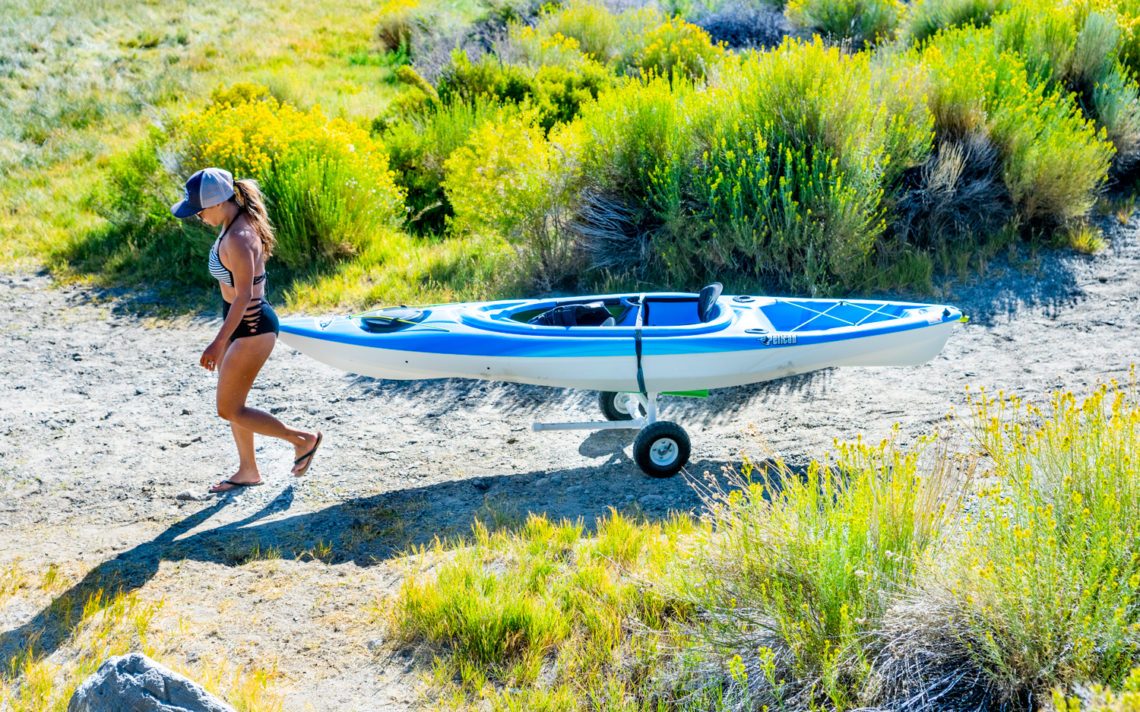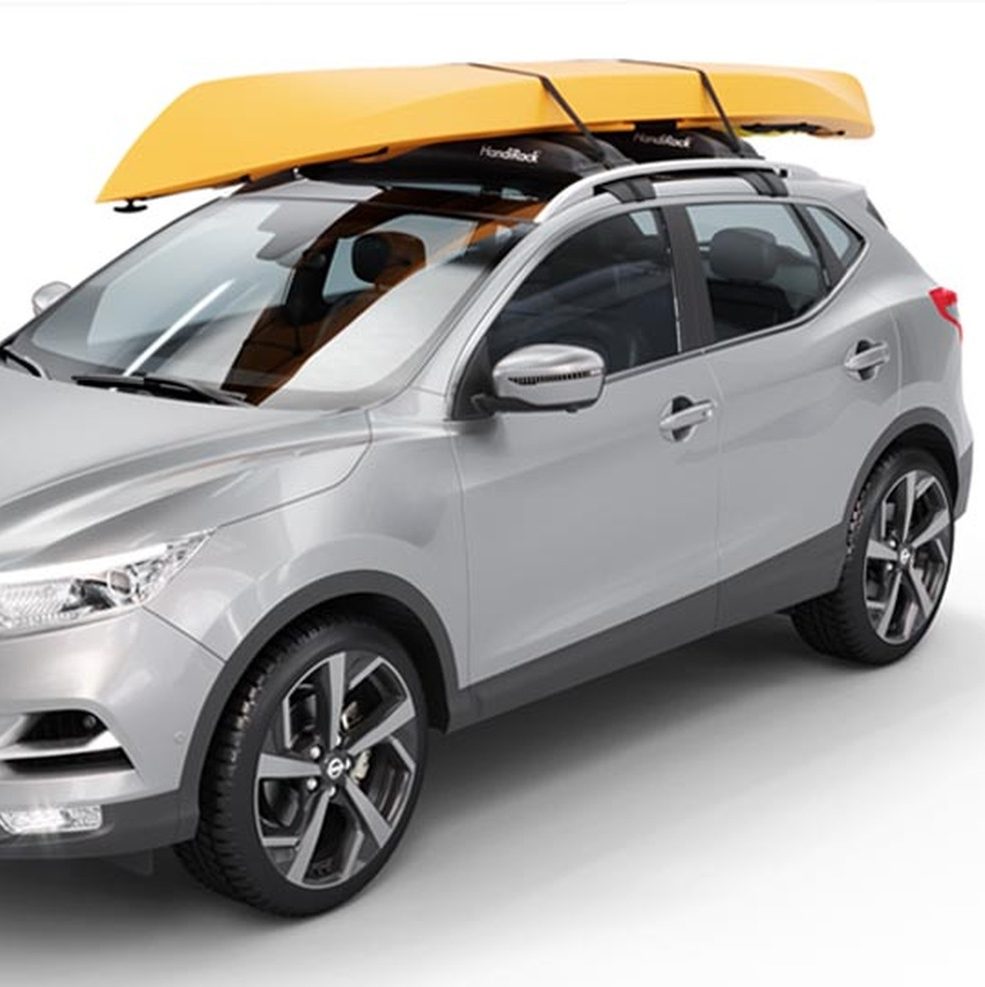Kayaking is a popular recreational activity, with around 18.12 million Americans participating in this sport in 2020. However, as with most sports, transportation of gear and equipment, especially as sizable as kayaks, is always an obstacle that you have to take into consideration.
Fortunately, there are many solutions on how to transport a kayak, all of which will be covered in this comprehensive guide.
How to Transport a Kayak by Hand
The average weight of a recreational kayak is around 35-pounds for a single kayak and about 65-pounds for a tandem kayak. Kayaks are heavy and therefore it is important to carry them in ways that will not cause harm to you, or damage the kayak itself.
If you have a history of back pain or injuries, take care to lift your kayak using your legs, and not your back.
Carrying a Kayak Solo
Carrying a kayak by yourself should be done with the following steps in mind:
- The kayak should be laid on the ground with the cockpit facing upwards.
- Bending down in a squatting position, grab the side of the cockpit closest to you with both hands.
- While holding on to the edge of the cockpit, stand up slightly and lift the kayak up towards you until the hull of the kayak is resting on your thigh.
- While the hull is rested on your thigh, stabilize the kayak. Grabbing the other side of the cockpit with your other hand, pull the furthest side of the kayak up to your shoulder and let it rest comfortably.
- Stand up completely and take the time to ensure that the kayak is balanced on your shoulder, and once stabilized you can start carrying the kayak towards the water.

Carrying a Kayak With Help
Naturally, carrying a kayak with help is much more convenient than having to do it on your own. Carrying a kayak with the help of a second person is best done with the following steps:
- The kayak should be laid on the ground with the cockpit facing upwards.
- Have one person squatting down at the front of the kayak, and another at the back.
- With each person grabbing their end of the kayak, lift the kayak at the same time. If the kayak is empty, then it’s best to lift and carry it using the carry handles. However, if the kayak is loaded, rather carry the kayak by wrapping your arms around the hull of the bow and stern ends to lift and carry it.
- Lift using your legs, not your back.
- If both persons carrying the kayak are stable and comfortable, start walking towards the water. The person walking in front should be aware of any tripping hazards as warm the person in the back to be aware of them.
- When reaching the water, make sure that you and your partner are both ready to place the kayak down. Lower the kayak simultaneously by bending your knees and placing the kayak on a clear patch of ground.

Carrying a Kayak With a Kayak Cart
If you’re a solo kayaker and not comfortable with physically carrying your kayak on your own, then a kayak cart is a conveniently short-distance transportation solution. Kayak carts are simply a set of wheels that are attached to your kayak and are then pulled behind you as you walk to the water. These aren’t a great option when walking across uneven, rocky terrain.
Loading the kayak onto the cart is easy enough. You simply lift the kayak’s stern onto the cart and strap it down tightly. Once secured, you repeat the same process with the other end of the kayak.

How to Transport a Kayak With a Vehicle
Driving with your kayak can be a daunting task. Therefore, having a proper kayak transport system in place on your vehicle is paramount.
There are three primary vehicle transportation solutions for kayaks, each with its own pros and cons.
1. Kayak Roof Racks
These are the most popular kayak transport methods as roof-mounted kayak racks can be fitted to almost all vehicles.
To fit a kayak roof rack, your vehicle would need a roof rack and crossbars installed. If you will not be using specifically built kayak rack systems, tying down your kayak on foam blocks along with your vehicle’s roof rack will be sufficient.
Kayak roof racks are available in a variety of different types to choose from.
- Crossbars and side rails: Some vehicles, like SUVs, are factory fitted with side rails or crossbars. If your vehicle does not have a roof rack system installed, you will have to purchase one before getting a kayak roof rack.
- Temporary or removable roof racks: This is another option for vehicles that have no roof racks, such as sedans and hatchbacks. These are roof rack alternatives that can be easily placed on the roof of your vehicle and easily removed once it is no longer needed. They often come in the form of foam blocks or inflatable nylon cushions.
Kayak roof rack attachment types
After an appropriate roof rack system has been attached to your vehicle’s roof, you will be able to install a kayak roof rack. These come in a variety of different styles with different general purposes.
J-Cradle Kayak Racks
With these padded kayak racks, the kayak itself is loaded on its side. This aid in preventing kayaks, particularly plastic ones, from becoming warped while mounted. J-cradle racks also enable you to mount up to two kayaks, side by side.

Saddle Kayak Racks
Many kayak enthusiasts prefer this rack style. The saddle is attached to a roof rack, and is compact and normally cushioned. Kayaks are loaded onto the saddle rack, usually positioned in the middle of the hull, and attached with rope or strap. For additional support, some people usually prefer two pairs of saddles; providing support to the stern and bow.

Stacker Kayak Racks
A Stacker rack makes it possible to transport multiple kayaks at once on your vehicle’s roof. Kayaks are stacked on the sides, much the same as with J-cradle racks. If you prefer using a roof rack to transport multiple kayaks, instead of a trailer, then a stacker kayak rack is your best option.

Inflatable Kayak Racks
If you want to know how to transport a kayak without a roof rack, this is your answer. Foam blocks and an inflatable rack add padding between the roof of your car and kayak, protecting both from damage. These are normally secured through the use of ropes or straps.

2. Truck Bed Kayak Racks
Pickup trucks are a very convenient vehicle to transport kayaks in. Little to no modifications are necessary. If you’re wondering about how to transport a kayak in a truck, kayak truck bed racks his the perfect solution. They have simplistic designs and are mounted on top of the truck bed. Some racks do require drilling in order to be installed. They can normally fit two kayaks.
If you’re not keen on actual rack structures on top of your truck bed, then you can load two kayaks directly into your truck bed. Two kayaks can usually easily fit in the truck’s bed by opening the tailgate, carefully loading the kayaks, and securing them with ropes or ratchet straps.
Depending on the length of your kayak, you can transport it by either leaving the tailgate open or closing it. Just make sure to attach a red flag at the end of your kayak to clearly indicate that there is an overhang.
You also have other options for transporting kayaks in your truck bed by means of a truck bed extender.
3. Kayak Trailers
If your vehicle is equipped with a hitch and capable of comfortably pulling light loads, this is a fantastic option for transporting a large number of kayaks at once. Most roof racks for kayaks transport between two to four kayaks, however, for a larger number, a trailer is the best option for a large groups of kayakers. Generally, these trailers can carry up to six kayaks, but some kayak trailer models are able to accommodate up to fifteen kayaks at the same time.
A kayak trailer is also a great way of transporting extra kayak equipment and accessories. Being low to the ground is a huge advantage for kayak trailers since this makes them much easier to load than roof-mounted kayak racks. The downside is that driving with a large trailer hitched to your vehicle isn’t something that everyone feels comfortable with.
How to Safely Load a Kayak Onto a Roof Rack
Loading a kayak onto a roof rack can be a bit tricky, especially if you don’t have additional help. Knowing how to mount your kayak properly is vital in order to protect your kayak and vehicle from scratches and damage.
Loading and Securing Your Kayak on Your Own
It is easiest to load your kayak by placing it behind your vehicle with the kayak’s bow pointed towards the vehicle’s trunk.
Carefully pick up the kayak on the bow’s side and place it onto the rear part of the kayak roof rack. Take care to mount it fully onto the rack in order to avoid scratching your vehicle.
Lifting the stern off the ground, push the kayak into place on the roof rack. Make sure to tie it down properly to avoid it coming undone during transportation.
When loading a kayak onto a J-cradle rack, this process is repeated in the same way, except that kayaks are loaded from the side of your vehicle, instead of from the rear.
If you’re physically not capable of lifting the kayak on your own, consider investing in a kayak lift-assisted system.
Loading a Kayak With Help
It goes without saying that having additional help when loading kayaks makes things a lot easier.
First, start by carrying the kayak to the vehicle by holding the kayak by its front and rear ends, sharing the load with your partner.
Place the kayak facing upwards, parallel to your car. The bow should face the front of the vehicle. Grabbing the kayak by its hull, on both ends, lift it overhead simultaneously.
Do not lift the kayak using your back. Lift with your knees to avoid injury.
At the same time, carefully slide one end of the kayak onto the roof rack. When the first end is securely resting on the rack, pivot the other end into place and tie the kayak down.

Properly Securing Your Kayaks on Roof Racks
It’s very important to tie your kayak down properly in order to avoid possible damage to your vehicle or kayak during transportation due to too much tension or not enough. When straps are wound too tight around the kayak, it may result in the kayak becoming warped or bent over time. Maintaining the proper amount of tension is imperative as it will keep the kayak securely in place, without compromising the shape of the kayak.
Cam straps or ratchet straps are the best options when tying down a kayak to your vehicle. Kayak roof racks usually come with buckles that help with tightening straps, so you wouldn’t have to master a bunch of knot tying techniques.
- Ensure that your kayak is centered properly on the rack. It should be running parallel to the car.
- After looping the tag end of the tie-down rope or strap beneath the crossbar, take the buckle end of the rope or strap down and then toss the tag end over the kayak to the other end of your vehicle.
- Pull the tag end until the buckle is between 8 to 12-inches from the crossbar. Make one more loop, insert it into the clip and pull the strap down to tighten it. Make sure that it is sufficiently tightened to secure the kayak to the roof rack, but not too tight so that it might warp the hull.
- Follow the same process a second time with another tie-down strap.
- It is important to tie both the bow and stern of the kayak to prevent it from turning side-ways during transit. Use the kayak’s front and rear handles as anchor points to thread the strap or rope through and then tie it to the tow points located on the front and rear ends of your car.
If you have invested in a truck bed rack for your kayak, the loading method follows a similar process.
Important Safety Tips When Transporting a Kayak
Take Enough Time to Secure Your Kayak Properly
Take enough time to make sure that you have loaded and secured your kayak properly. Do not rush it. A poorly secured kayak is extremely hazardous during transportation to yourself as well as fellow road users.
Use Cockpit Covers When Transporting Your Kayak
This is useful in preventing harmful and damaging debris from entering the cockpit during transit.
Make Use of Quality Ratchet Straps
When driving with a kayak loaded onto your vehicle, the force of the oncoming air moving over the kayak is immense. It is capable of warping the shape of the kayak or having it shift and bounce while you’re driving, which may cause damage to it, or have it fall off completely. Kayak rack systems often come with high-quality ratchet straps or tie-down ropes, it is important that you use them instead of general-purpose ropes or straps.
Inspect Your Ratchet Straps From Time to Time
When traveling long distances with your kayak, take the time to stop and check all your tie-down straps. Make sure that everything is still held in place, and that the straps are still tied down securely. Check for any loose knots and make sure to tighten them properly.
Hang a Red Flag to Indicate Overhanging Objects
This is an important road safety precaution that should be taken seriously, as in some states it is actually a law. Most kayaks are long and will have the bow hanging over the rear of your vehicle. Always hang a red flag or cloth on the back of the kayak to make other drivers aware of the overhanging object.
A UK native, passionate writer, and outdoorsman, Nathan enjoys piercing words together to share his knowledge on cycling, kayaking, and camping in intriguing and engaging ways. As a father to twins and a keen runner, he is passionate about helping people make the most of their time and health.







